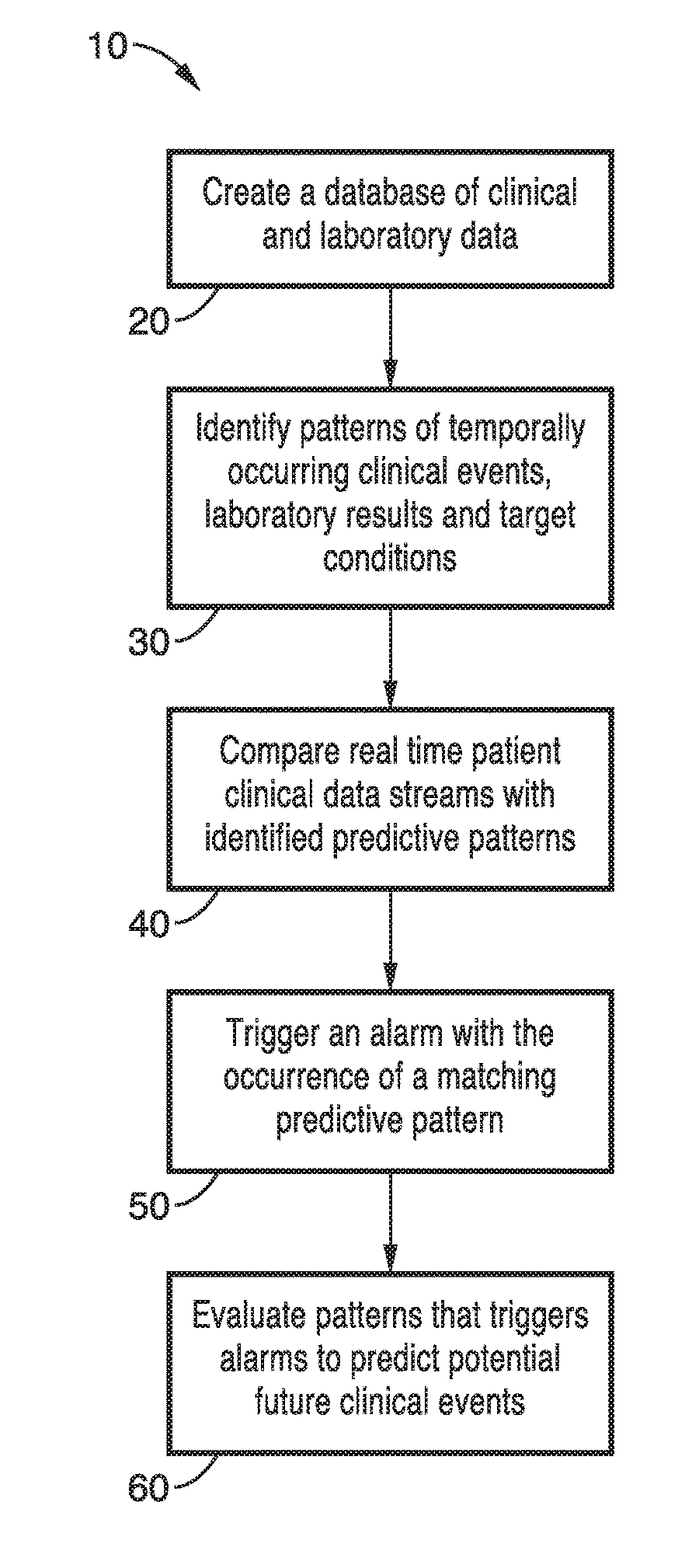Recognizing predictive patterns in the sequence of superalarm triggers for predicting patient deterioration
- Summary
- Abstract
- Description
- Claims
- Application Information
AI Technical Summary
Benefits of technology
Problems solved by technology
Method used
Image
Examples
example 1
[0046]In order to demonstrate the technology, two approaches to integrate monitor alarms with laboratory test results and then use maximal frequent itemsets mining algorithm to find SuperAlarm patterns from the integrated dataset were tested. A final set of SuperAlarm patterns were generated by using the optimal parameters determined based on a 10-fold cross validation of the training data. Those SuperAlarm patterns were further filtered out if their false positive rates based on training data were greater than a user-specified FPRmax.
[0047]The performance of SuperAlarm patterns were assessed in two aspects using an independent test data set not used in the training phase. In the first aspect, sensitivity with respect to prediction window and sensitivity with respect to lead time, respectively were calculated. In the second aspect, the ratio of a number of SuperAlarm triggers to that of the monitor alarms for control patients were calculated. Performance of SuperAlarm patterns compo...
example 2
[0079]To further demonstrate the operational principles of the methods, a time series that represents the cumulative effects of each SuperAlarm, dependent on time elapsed between the current time and the previous time each SuperAlarm patterns were triggered, was generated. This representation encodes both frequency and proximity in time, and could be easily used in any application concerned with time series classification. SuperAlarm patterns are combinations of frequently co-occurring monitor alarms and laboratory test results that were capable of predicting code blue events in hospitalized patients. The SuperAlarm patterns were then discovered using a maximal frequent itemsets mining algorithm. They were further filtered by excluding patterns that were present only in a very small number of patients that had a high false positive rate.
[0080]The dataset used to extract the SuperAlarm patterns was extracted from a central repository of comprehensive data elements archived for patien...
example 3
[0100]To further demonstrate the methods, in-hospital code blue events were predicted using a term frequency inverse document frequency based kernel. As illustrated in Example 2, the maximal frequent combinations of monitor alarms and laboratory test results (e.g. SuperAlarm patterns), were shown to be capable of predicting code blue events in hospitalized patients.
[0101]This approach was further developed to differentiate the patterns in the sequence of SuperAlarm triggers between coded patients and their controls with the goal of further reducing false SuperAlarm triggers. This embodiment is based on using support vector machine (SVM) with term frequency inverse document frequency (TFIDF) based kernel to measure the distance between two sequences of SuperAlarm triggers.
[0102]SuperAlarm sequences were generated for both code blue patients and control patients by applying the SuperAlarm patterns to the sequence of monitor alarms and laboratory test results. To train SVM, six-hour lo...
PUM
 Login to View More
Login to View More Abstract
Description
Claims
Application Information
 Login to View More
Login to View More - R&D
- Intellectual Property
- Life Sciences
- Materials
- Tech Scout
- Unparalleled Data Quality
- Higher Quality Content
- 60% Fewer Hallucinations
Browse by: Latest US Patents, China's latest patents, Technical Efficacy Thesaurus, Application Domain, Technology Topic, Popular Technical Reports.
© 2025 PatSnap. All rights reserved.Legal|Privacy policy|Modern Slavery Act Transparency Statement|Sitemap|About US| Contact US: help@patsnap.com



